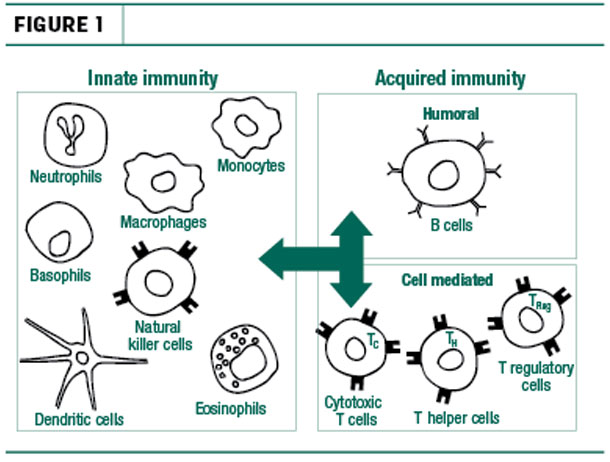The area of most confusion related to herd health management on dairies continues to be the vaccine program. It is rare to find just one vaccine protocol for any farm.
The protocol at the vet clinic is different from the copy in the main farm office, which is different from the copy back in the manager’s office (recognizable by all the hand-written changes and crossed-out vaccinations on it).
Much of this confusion can be traced back to two things. First, without an understanding of basic immune function, people managing the day-to-day vaccinations (when faced with inevitable challenges) make modifications that may increase the risk of health problems for the cows. Second, vaccination programs often lack a procedure to manage through situations that strain the protocol.
Immunology and vaccines
Immunology is a complex and constantly evolving field of research. However, it is not necessary to delve too deeply in order to understand how the vaccines we give work. The goal of the vaccine protocol is to safely and cost-effectively increase the herd’s ability to resist future disease challenges.
When a pathogen gets past the first lines of defense, the innate (non-specific, non-adaptive) immune system finds and begins to destroy it. The innate immune system then signals the adaptive (acquired) immune system. The adaptive immune system generates a more robust response to specific pathogens. There are two branches of the adaptive immune system.
 The humoral branch includes B-cells that produce antibodies which circulate throughout the body. Antibodies bind to invading micro-organisms and assist in their destruction and removal.
The humoral branch includes B-cells that produce antibodies which circulate throughout the body. Antibodies bind to invading micro-organisms and assist in their destruction and removal.
The other branch, cell-mediated immunity, is made up of T-cells primarily. They respond to intracellular pathogens like viruses. These two branches generate memory which can last months, even years. Should that same pathogen invade again, the memory cells set into motion a rapid and overwhelming response to eliminate it.
This often happens without the animal showing signs of illness. The parts of the immune system are mentioned separately here, but it is important to know they work together to coordinate responses to pathogens. Unfortunately, this specialized response to a novel agent can take weeks to develop, and the animal will likely get sick in the interim.
Vaccines work by presenting a pathogen’s antigen to the immune system to generate an adaptive response and stimulate memory without the animal getting sick. The goal when designing a vaccine protocol is to give vaccines long enough prior to a possible disease challenge for the immune system to generate a response – but not so far in advance the memory is lost by the time a disease challenge takes place.
The immune system responds differently depending on the type of vaccine used. Killed vaccines contain antigen associated with a pathogen or its toxin. Modified live vaccines contain attenuated (altered and weakened) versions of the pathogen which then replicate in the animal and allow the immune system to respond similarly to how it would if the real pathogen invaded.
It is generally accepted modified live vaccines products tend to stimulate both humoral immunity and cell-mediated immunity, start providing protection after a single vaccination and provide a longer duration of immunity (how long the animal is protected after vaccination) compared to killed vaccine products.
However, modified live vaccines are more easily damaged by mishandling, must be used in just a few hours after reconstitution, and not all animals can be given these products safely. It is for these reasons veterinarians utilize a mix of vaccine products when coming up with each farm’s vaccine protocol.
Immune suppression is something animals can face at various times in their lives, and they are put at increased risk of disease when it happens. It is well understood birth, weaning and calving are common times of significant stress. Poor nutrition and other stress events (like severe heat or cold) can weaken the immune system too.
Vaccine protocols take this into account by choosing specific products and timing of immunizations to work around immune suppression. Your veterinarian will also ramp up protection from diseases in advance of potential immune suppression to help animals get through it without getting sick.
Protocol drift
When I see several different vaccine protocols on a farm, I know there has been a communication breakdown. Certain vaccine serials can be hard to find for a while, or someone might stop by the farm with a great deal on a “similar” vaccine. Although the same diseases are on the labels, different manufacturers likely use different techniques, master seedstock and adjuvants, and the switch in products could create a gap in protection.
Employees could find it difficult to give the vaccine when the protocol says it should be given. The new time they give it instead may not line up with booster timing recommendations or be a time when the immune system cannot adequately respond. A vaccine may appear to not be working or, worse, making animals sick.
Perhaps the sickness is unrelated to the vaccine, or the vaccine has been mishandled, making adverse reactions more likely.
The farm may see a sudden increase in disease incidence and plug in a new vaccine without a lot of consideration. When examined further, the product may lack the evidence it will help in this situation or, worse, contraindicated in the animals you wanted to give it to (some vaccines should not be given to animals less than 6 months old, for example).
These are just a few causes of vaccine protocol drift. To help avoid this, make sure everyone responsible for managing herd health has a basic understanding of immune function and you have a process in place to address protocol issues in an organized way to ensure the best solutions are found for your herd. ![]()

-
Robert Lynch, DVM
- Dairy Herd Health and Management Specialist
- Cornell University
- Email Robert Lynch, DVM








